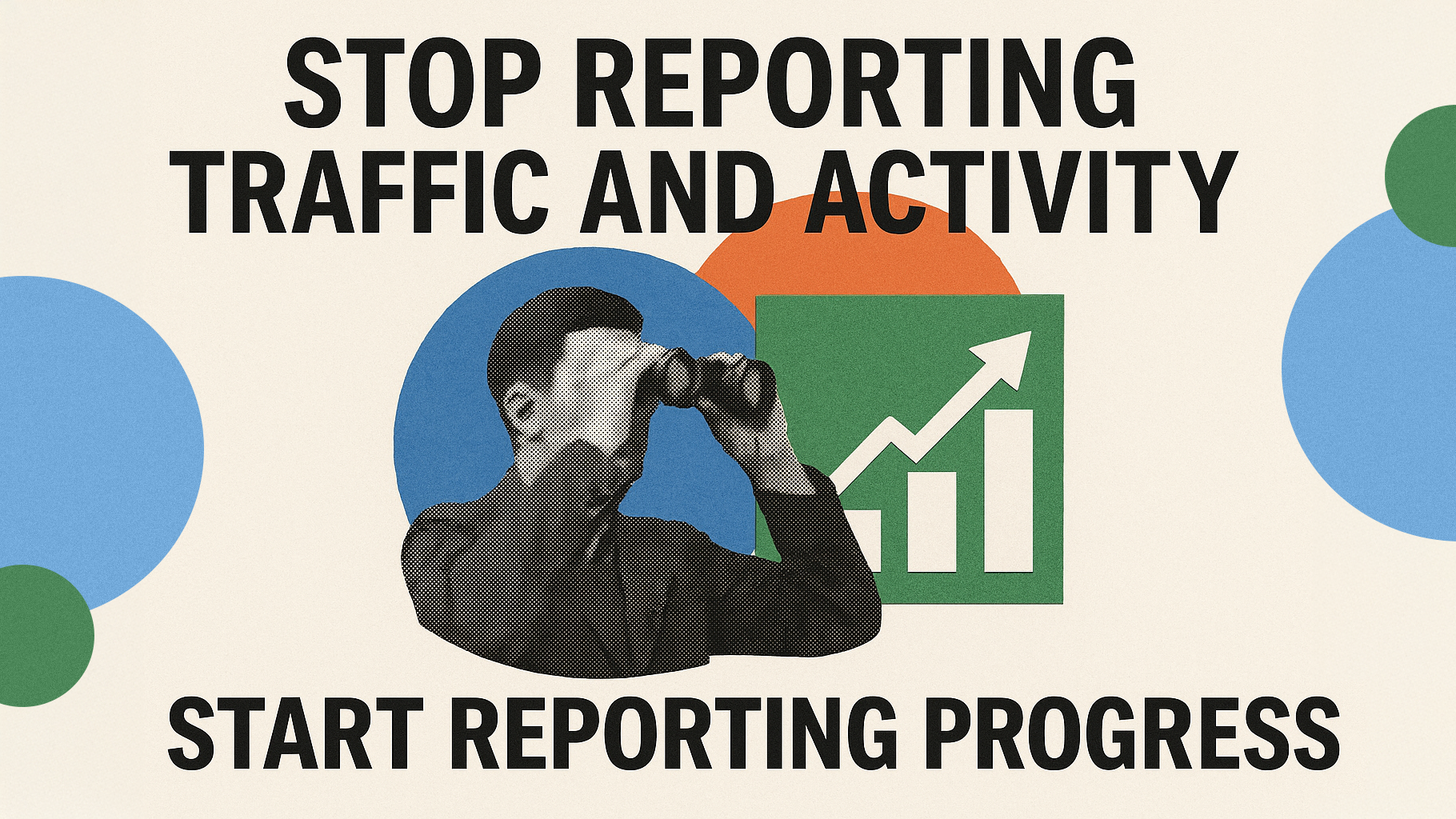Stop reporting traffic and activity. Start reporting progress.

For over a decade, Google rewarded rankings with visits, so SEO practitioners learned to justify success with rankings, clicks, and traffic. For a long time, that proxy worked. But in B2B, it was always fragile—and now it’s collapsing. Zero-click searches siphon visits, SERP features crowd out listings, and generative engines influence early discovery with answer-first experiences. What once looked like performance is now little more than hope-based marketing.
The real challenge for practitioners has never been about proving activity—it’s been about translating our expertise into outcomes the business actually cares about.
Aligning with business objectives is critical
I saw this clearly when I was at Optus. Sales were falling short, and I used that moment to highlight critical technical SEO issues—a lack of canonicals, content rendered entirely client-side—that were holding back indexed pages and discoverability.
But the point wasn’t the technical fixes themselves. It was that I aligned our SEO problems with the business problem leadership already cared about: revenue.
Pages indexed, YoY traffic, and visibility are too far removed from revenue to make a CMO, Director, or MD care. The only way to cut through was to show how fixing those issues would unlock sales. And this is the advantage we have as SEO practitioners: We are recruited as subject matter experts. Our depth of knowledge gives us leverage—but only if we frame it in the language of the business.
That’s the bar for every metric we keep: If it can’t predict resourcing and revenue with confidence, it doesn’t belong in our deck.
And to be fair, there was one arena where the old traffic-based proxies held up better: ecommerce. If SEO drove 50,000 additional visits and 2% converted, the impact on revenue was visible in the cart. Rankings and traffic were imperfect, but they were close enough to the business outcome. SEO tools reinforced this thinking, serving up estimated keyword traffic and conversion potential that made it feel scientific.
The math was simple: X searches, Y click-through, Z conversion rate. Dashboards turned it into certainty. But that certainty was always false—in B2B because the journey is never that linear, and arguably in B2C as well, where attribution was rarely as clean as the spreadsheet suggested.
In B2B, the gaps were obvious. You could drive thousands of visits to solutions pages and see no movement in qualified pipeline. Enterprise sales cycles stretch across months, involve multiple stakeholders, and require consistent brand presence to shape demand. Traffic as a proxy for success was always weak—and today, even that weak proxy is fading.
Google searches still matter, to an extent
It’s important to be clear: Emerging data suggests traditional Google searches aren’t collapsing as quickly as many predicted. People still rely on Google, especially when they’re validating vendors, comparing options, or chasing specifics. In other words, Google still plays a role in last-touch discovery.
But that doesn’t redeem rankings, traffic, or impressions. In B2B, those proxies were never reliable indicators of pipeline impact. They looked good in dashboards, but they told leaders nothing about whether the right accounts were moving closer to revenue. And now, with generative engines shaping the first touch, clinging to those proxies only widens the disconnect between what practitioners report and what leadership needs to see.
Rightsizing AI visibility
This is where the industry risks repeating old mistakes. Opportunistic vendors are already capitalizing on the hype, pitching “AI visibility” and “prompt volume” as the new KPIs for the generative era. On the surface, they look like clean, simple numbers—the same way keyword search volume once did. But prompt visibility is riddled with problems that make it even less reliable than the proxies we’re leaving behind.
AI visibility does matter—but it isn’t the holy grail. Monitoring how your brand shows up in generative engines can be useful, particularly for sentiment. Pre-determined prompts, checked consistently, can reveal whether your messaging is being reinforced, ignored, or distorted. That makes AI visibility a slice of reality—a signal to react to—not a universal source of truth.
The danger is when practitioners start treating those snapshots as KPIs. Visibility in an LLM output doesn’t equal demand, influence, or movement in a buying journey. It’s not proof of impact, it’s just one lens.
Prompt volume, on the other hand, is even weaker. Most of the “activity” isn’t human at all. It’s inflated by bots and synthetic testing tools designed to manufacture data for dashboards. It’s an ouroboros—tools prompting other tools to generate numbers that justify their own existence. It also confuses activity with intent, offers no signal quality, varies across users, and is unstable by design.
Worse, the methodology is opaque. Tools rarely disclose how prompts are gathered, which models are queried, or how results are normalized. And none of it is revenue-adjacent. Prompt volume doesn’t map to account engagement, buying committee coverage, or pipeline velocity. It’s traffic 2.0: easy to count, easy to report, and useless as proof of business impact.
Find Your Site’s SEO Issues in 30 Seconds
Find technical issues blocking search visibility. Get prioritized, actionable fixes in seconds.
Start tying SEO to revenue
This is why enterprise SEO practitioners need to stop reporting vanity metrics and start reporting revenue-adjacent outcomes. Not “were we visible?” or “did traffic grow?” but “did we reach the right accounts, did we move buying committees closer to a decision, did we expand pipeline coverage?” These are the only metrics CMOs, Directors, and MDs will care about—and the only ones that make SEO strategic.
I’m reminded of a conversation with an Adobe VP who, whenever we discussed declining organic visits, would cut through the noise with a simple question: “Did this traffic matter?” It was a blunt reminder that volume on its own doesn’t count for anything. If you can’t show that the traffic connected to revenue outcomes, you haven’t answered the question that leadership actually cares about.
Track the full journey
Better measurement starts with recognizing that clicks aren’t the unit of value in enterprise. Journeys are. The job isn’t to capture random visibility, but to show how SEO contributes to moving accounts from unaware, to engaged, to in-pipeline.
That requires evolving beyond SEO dashboards and keyword reports, and collaborating with cross-functional teams to track signals across the full cycle. In B2B, success doesn’t come from SEO working in isolation—it requires owned, paid, and earned channels beating to the same tune instead of operating in silos. Because LLMs don’t care about your internal politics. They aggregate whatever’s available. And if your brand signals are inconsistent across channels, generative systems won’t smooth them over—they’ll amplify the disconnect.
Reframe the role of content
Content still matters—but not in the way most practitioners frame it. It’s not about publishing volume, chasing keywords, or building so-called topical authority and coverage. Those are heuristics at best—useful for ideation, not for reporting. What matters is brand mental availability: making sure your organization is the one buyers think of when they finally enter the 5% who are in-market. The measurement question isn’t “did this content get traffic?” but “did it help keep us top of mind with the right accounts until they were ready to buy?”
Focus on the pipeline
Most SEO reports today are still theater. They package traffic, rankings, and impressions into neat reports—metrics that CMOs, Directors, and MDs know don’t prove revenue impact. To stay relevant, SEO practitioners need to reframe measurement around pipeline language: demand creation, account coverage, and journey velocity. That doesn’t mean abandoning technical SEO or content. It means making the case that both are levers for shaping journeys, and backing that case up with metrics leadership actually cares about.
Evolve forecasting models
Forecasting has to change too. The age-old model—traffic multiplied by conversion rate—is dead. It was always a crude shortcut, even in ecommerce, where it ignored seasonality, merchandising, pricing, and competition. But in enterprise B2B, it was pure fantasy. Forecasting based on visits assumes people convert independently, instantly, and predictably. That was never how buying committees made decisions, and it certainly isn’t now.
But forecasting still matters. Its purpose isn’t just to predict outcomes—it’s to secure resourcing and leadership support by providing certainty. VPs, SVPs, CMOs, and the CEO want to know that investments in SEO aren’t bets, but planned contributions to pipeline maturity. That’s why practitioners can’t abandon forecasting when the old model breaks. We need to evolve it.
The new forecasting model has to be built around journeys, not sessions. That means shifting inputs from traffic volume to account signals:
- Reach: % of ICP accounts with qualified engagement across owned, paid, and earned channels.
- Coverage: # of priority roles engaged per account vs. role map.
- Velocity: Median days between journey stages.
If Reach grows by 10%, Coverage adds a new role per account, and Velocity shortens by two weeks—what does that mean in qualified accounts and pipeline coverage? That’s the language VPs, SVPs, CMOs, and the CEO will respond to.
And the tools exist today to make this shift:
- Adobe Real-Time CDP unifies known and unknown data into account-level profiles.
- Customer Journey Analytics connects engagement signals to revenue outcomes across channels.
- Enrichment layers from providers like Bombora or 6sense tie anonymous intent back to accounts.
These platforms make it possible to model journeys in a way SEO dashboards never could.
This is the future of SEO forecasting: not multiplying traffic by a conversion rate, but projecting how improvements in journey health drive account progression and pipeline growth. It’s harder. It’s messier. But it’s more strategic—and it’s the only way SEO earns credibility in the boardroom.
Stop reporting traffic and activity. Start reporting reach, coverage, and velocity. Forecast pipeline maturity with enough certainty to secure budget. Tell them what you did mattered—because it progressed accounts and pipeline—and how what you plan to do next will do compound those results. That’s the only answer leadership will fund.







Recent Comments